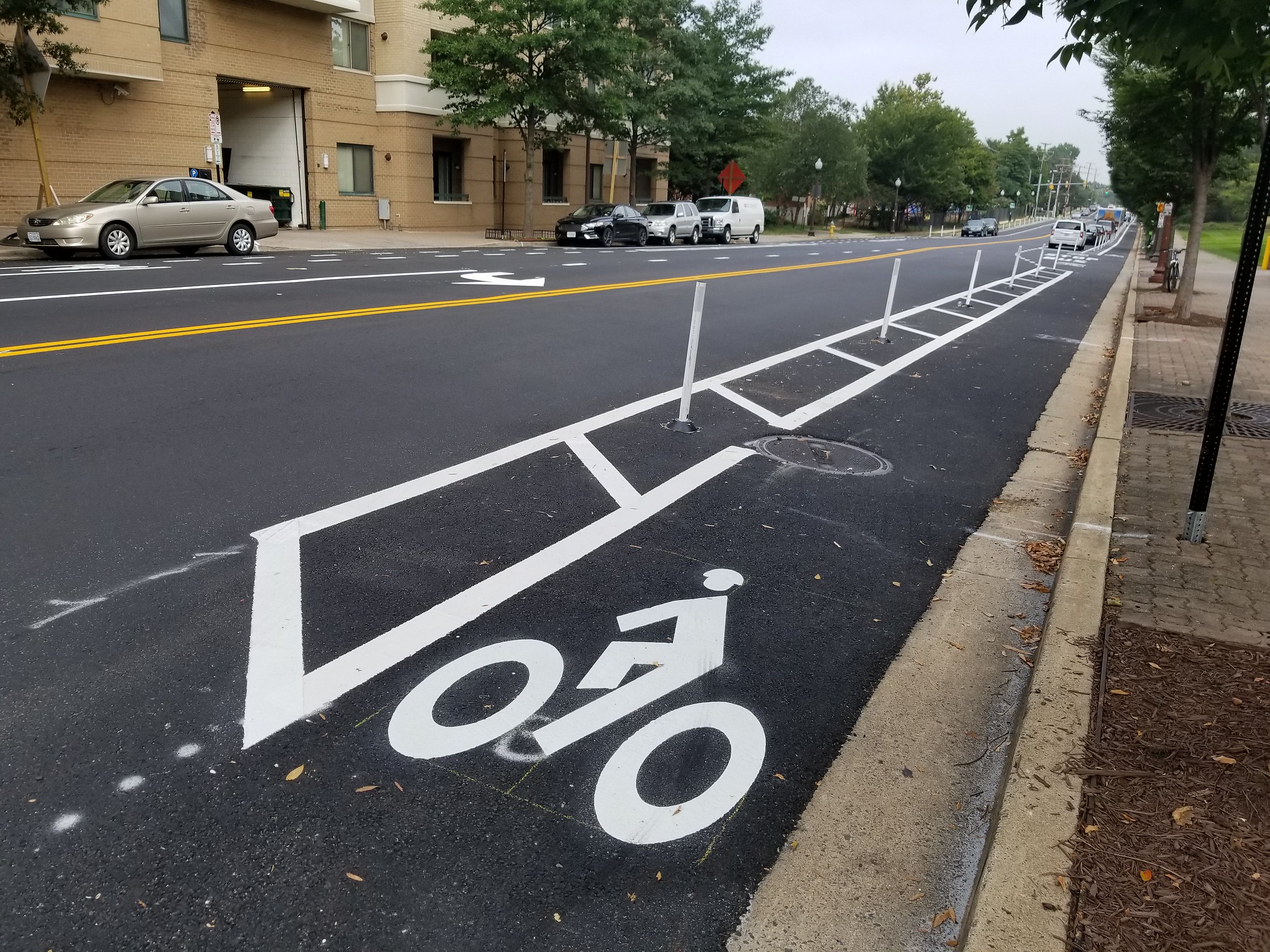
Taking Back Texas’ Streets
TxDOT has blocked a plan in San Antonio to turn two lanes of a major thoroughfare into bike paths. What does it mean for other cities?
Whether sharing dry recitations of road-design timelines, impassioned calls for local control, or just general bewilderment, all the speakers at the January 27, 2022 Texas Transportation Commission (TTC) meeting were united around a cause: asking the state to relinquish part of a roadway to the city of San Antonio.
A carousel of city officials and mobility advocates took the stand urging the commissioners to delay a decision that soon would reveal itself to be a foregone conclusion. The state refused to budge. It would not follow through on years of work that would have transformed two of the six-car lanes into bike lanes on Broadway, also known as State Loop 368, which passes through the northern end of the city and into Alamo Heights.
“We cannot reduce capacity,” TTC Chairman J. Bruce Bugg Jr. said multiple times after the speakers finished. Despite not physically being in the room, Governor Greg Abbott’s presence was also felt. Bugg cited a statement from the governor that read in part: “Governor Abbott’s priority is to alleviate congestion on our state highway system. A recent local proposal to remove travel lanes along State Loop 368, which has been and continues to be on the state highway system, would run counter to that goal.”
Broadway, a Texas Department of Transportation (TxDOT) road, was set to become a city road after the state agreed to eventually transfer control in 2014. San Antonio made revitalizing the road a key part of the 2017 voter-approved bond package—$42 million of which would go toward the estimated $113 million Broadway project. After years of collaboration, the state’s tone changed in the fall of 2021. State officials said studies showed the road would move less traffic at peak hours. City officials found the opposite—more traffic would flow through the 2.2-mile stretch that would help connect the University of the Incarnate Word to the Pearl District.
TxDOT officials pointed to the lack of cyclists in the city as reason to prioritize moving cars efficiently. However, for Bryan Martin, a Bike San Antonio board member, the lack of cyclists is a result of years of underinvestment in bike infrastructure. Martin, who sees San Antonio as about 20 years behind the cycling infrastructure curve, said San Antonioans have been asking for a bike lane on Broadway since the 1980s. He has been an active advocate for the project.
“In my mind, as somebody who donated a year of my time, that’s a pretty big F-U from TxDOT to the taxpayers here in San Antonio,” Martin said.
He noted that if not for Bike San Antonio’s presence, Broadway planning meetings would have been devoid of a bike advocacy presence. While Martin was surprised by TxDOT’s reversal, he said he is aware of how conservatives view investment in bike projects.
“Just the pure act of trying to ride a bike for transportation is a political statement,” Martin said.
A TxDOT media advisory from January noted that a Broadway project for the corridor is in the planning stages. The first segment would cost around $16 million and would address “safety, maintenance, and operational enhancements to repair the roadway, add ADA accessibility to intersections, and improve sidewalks and curbs.” It made no mention of improved bicycle infrastructure. A city of San Antonio spokesperson said there is no mutual project between it and TxDOT at this time.
The Broadway project is a part of TxDOT’s turnback program, which dates back to 2013. The state would turn over control of roads to local authorities as a way to reduce costs. A 2013 Austin American-Statesman article quoted TxDOT’s chief engineer at the time John Barton as saying the program would target roads that “look like local streets, most people perceive them as local streets and yet … are a part of the state highway system.” At first cities balked at the idea of having to take on the financial responsibility that would come with managing new roads, but, as city and state road priorities continue to diverge, the avenue is becoming appealing to some cities.
TxDOT did not respond to fully comment on the turnback program but did confirm that the turnback program still exists. “TxDOT’s agreements with local jurisdictions now regularly include language restricting future lane reductions,” the spokesperson added.
Broadway is hardly the only example of a TxDOT-owned road that has become subsumed by the state’s growing metro areas. For example, long stretches of Lamar Boulevard in Austin and Westheimer Road in Houston are owned by the state. Martin pointed to Bandera Road as another state-owned road in San Antonio. Cities and advocates are now concerned that the state might clamp down on their projects that both directly and indirectly involve TxDOT roads.
Alamo Heights voters took to the polls in 2020 to approve a $13.25 million bond to improve a 0.7-mile stretch of Broadway. Alamo Heights, San Antonio, TxDOT and other stakeholders had been involved in the plan for years, including the lane reduction component, according to Alamo Heights City Manager Buddy Kuhn. “We were planning the entire time with TxDOT, with the San Antonio office. That was in the plans from the word ‘go,’” Kuhn said. “The only ones surprised was us and so it was a complete about face from what we had worked on for several years.”
As San Antonio sorts through the project’s fallout, Alamo Heights has opted to work with TxDOT. Kuhn said the city has been meeting with the state transportation agency roughly every two weeks since August. “The chairperson, Bruce Bugg, has said that there won’t be any reduction in lanes, so we have kind of acquiesced to that,” Kuhn said. ”So what can we do and what options do we have for beautification? Because the big thing for us with the flood control is we have businesses that flood along Broadway.” He added that TxDOT has said it is willing to go through with a project that includes beautification efforts and burying power lines, as long as it does not involve any lane reductions.
The City of Houston doesn’t necessarily have the same enthusiasm for taking on state roads, according to Veronica O. Davis, Houston Public Works’ director of transportation and drainage operations.
“We have 15,000 lane miles. I don’t know that we’re in a rush to accept any additional lane miles at this time,” Davis said.
Houston has a complex system for making changes to roads. Project implementation on city roads can come from Harris County precincts, management districts, and tax increment reinvestment zones. While local authorities manage most urban streets in Houston, the city does have some state-owned roads, including parts of Westheimer Road and McCarty Road. Davis added that the city is aligned with TxDOT’s plans to expand McCarty—a road she described as having “heavy, heavy truck traffic.” However, she added that the city is handcuffed in some ways by state policy, pointing to limitations on how cities can set speed limits.
Houston mobility advocates have noted the challenges of working with the state. Michael Moritz, an organizer with Stop TxDOT I-45, pointed to the 2017 bike plan approved by the Houston City Council and the city’s voters approving the MetroNext $3.5 billion transit investment in 2019, as examples of the direction that Houston has started to take on multimodal streets.
“But then you have TxDOT, and you have TxDOT’s projects right on the top of Houston and Harris County neighborhoods in a way that is entirely antithetical to the stated goals of the administrations governing Houston and Harris County,” he said. “I think that [transportation] issue is the biggest one that this region faces. It’s the difference between state and regional interests and things that are being emphasized and what the goals are.”
According to Moritz, a barrier-protected bike lane on Walnut Bend Road was supposed to be implemented. However, because the Houston-Galveston Area Council used funding from the state for the West Houston project, the road needed to follow the state’s design manual. As a result, it wound up being widened, and the bike lane became a strip on the shoulder, Moritz said. While the original aim of Mortiz’s organization was to push back against the expansion of I-45, the group has expanded its efforts to broader policy goals, including an initiative that would give Texans the chance to vote on a constitutional amendment allowing TxDOT to put more dollars toward multimodal projects.
The Shepherd Durham improvement project is another example of a local project that faced pushback from the state. Nick Arcos, director of communications for the transit equity nonprofit LINK Houston, said the project was going to have 12-foot wide sidewalks but the state, which partially funded the project, capped that number at 11 feet.
“It was just the one foot that they had to give up,” Arcos said. “It’s not as significant as what TxDOT did to San Antonio on Broadway Street. They’re still definitely making their voice heard when it comes to these streets in Houston.” He added that Westheimer Road, a TxDOT road, is one of the city’s most dangerous because it is so wide.
One of the main goals of transferring control is improved safety. A report from the nonprofit Farm & City found that the number of fatalities on TxDOT boulevards rose from 80 in 2012 to 144 in 2021—an increase that far outpaces the state’s population growth. While this number represents a fraction of the state’s total traffic deaths—4,479 in 2022—the trend runs sharply counter to the Vision Zero goals of cities like Austin, Houston, and San Antonio.
In Austin, 75 percent of traffic fatalities happened on TxDOT roads in 2022—an increase from the 69 percent share in 2021. The city currently has several mobility projects on state-owned roads thanks to a string of voter-approved projects in recent years. According to an Austin Transportation Department spokesperson, the city continues to work closely with the state on those projects. To do so, it must navigate differences in design standards.
“State design standards are set with different priorities, such as quickly connecting people across urban and rural environments, whereas City design standards are more tailored to our urban environment,” the spokesperson added.
Adam Greenfield, board president of Safe Streets Austin, would like to see cities shift away from car dependence through the construction of bus lanes, protected bike lanes, and less parking to name a few suggestions. Greenfield noted that this is a critical moment in TxDOT’s history.
“TxDOT is way behind the curve on transportation, which is the one thing that they’re meant to do,” he said. He pointed to “younger people” working at TxDOT that want to shift away from cars and implement multimodal streets.
Greenfield said the city of Austin also tends to dedicate too much space to cars. However, he added that the city would be better suited to manage roads like Lamar Boulevard, Koenig Lane, and E. Martin Luther King Jr. Boulevard—all of which have segments or are entirely owned by the state. He has carefully watched what happened with the Broadway project in San Antonio. In particular, TxDOT’s argument that transitioning a car lane to a bike lane would reduce the street’s capacity perplexed him.
“That’s not true,” he said. Studies in Spain, New York, and other major cities around the world have found that converting car lanes into spaces for other forms of transport, like bike lanes, have led to decreases in car traffic.
The ripple effect of the Broadway project is now being felt in Austin. According to an anonymous source, TxDOT is currently saying it won’t help facilitate efforts to develop the Austin Core Transportation Plan, which could implement bike and bus lanes, as well as one-way to two-way treatments in the downtown area. Lamar, which sits on the west side of downtown and is owned by TxDOT, wouldn’t be altered in any way to accommodate those changes.
Justin Golbabai is an associate professor of urban planning at Texas A&M University, but he previously worked in planning roles for Austin and College Station. He found that cities tended to think they didn’t have a say in state-owned roads. He said there didn’t seem to be “a collaborative ‘hey, we have these shared interests. Let’s work together on it.’” He added that for redesigns, cities and the state would bring each other in for consultant-type roles for the projects.
Golbabai said it’s important to differentiate how state and city roads are funded. Cities generate most of their funding from their property tax base compared to the state which gets funding from the gasoline tax and federal grants. As a result, cities have an incentive to shift high-speed urban roads into multimodal streets that some scholars argue help to build financial wealth.
Overall, he thinks it makes more sense for urban roads to be managed by cities and for the state to maintain control of regional roads and described the turnback program as a “win-win.” In reference to the Broadway example, Golbabai noted that it is important to have the agreement on what can be built in some form of writing. “If TxDOT has certain parameters for what they don’t want, that’s upfront before we even get to the design process,” he said.
As other cities advance their own projects, San Antonians offered some advice. Kuhn, who remains optimistic about TxDOT doing right by the Alamo Heights community with Broadway redevelopment, suggested other cities wait to see what happens with their project. Martin, meanwhile, recommended a level of skepticism when working with TxDOT:
“Well, it really makes it hard to trust people. I would just say that the better you can organize and the better you can get your coalition together, all your bike groups and clubs together, the better off you’ll be,” he said.



